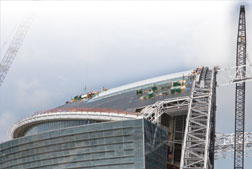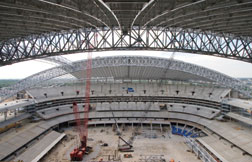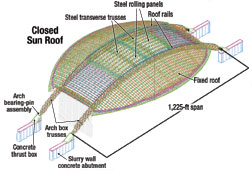 Daryl Shields / HKS Roofers are getting swelled ankles from working on steep slopes.
|
Never mind the whopping 2.7-million-sq-ft area, 1,225-ft-long steel arches, 25,000-sq-ft center-hung video board, 120-ft-tall movable end-zone walls and nearly $1.1-billion cost. The wildest statistic for builders of the Dallas Cowboys’ stadium in Arlington, Texas, is a mere 23.9°.
That’s the maximum curved slope for the design’s biparting roof panels and the genesis of the job’s myriad hill-climbs.
The steep curves inspired a first-of-a-kind rack-and-pinion gear-drive system to move the retractable panels. “Now we can do steeper slopes with confidence,” says Lawrence G. Griffis, senior principal in the Austin office of Walter P Moore, the roof’s structural engineer. When the multipurpose stadium opens in August 2009, WPM, in collaboration with roof-panel transporter-supplier Uni-Systems LLC, Minneapolis, will have completed five movable roofs in a decade.
|
The rack-and-pinion system pulls the panels uphill like a tractor pulls a plow. The hesitation was that the 656-ft-long steel rack fixed along the wheel rail atop each arch requires expensive machining. “Nobody’s done such a long, fixed rack for moving,” says Justin Waldron, Uni-Systems structural engineering manager.
But because of the steep slope, rack-and-pinion turned out to cost 25% less than a tried-and-true cable-drum drive. Also, extra drums needed for more than a 14° slope makes the tried-and-true system cumbersome. The Cowboys’ movable roof is costing $15 million of the $750-million construction cost.
 Daryl Shields / HKS Parallel steel arches, which support movable roof panels, span a quarter mile and slope as much as 23.9°.
|
The drive innovation is an indirect response to the direction of Jerry Jones, owner of the Dallas Cowboys Football Club. Jones wants the venue to replicate the roof opening of the team’s current home. He also wants a new architectural icon. Dallas-based HKS Sports & Entertainment Group responded with a sleek shape that resembles a creature on all fours. The parallel sideline box-truss arches extend beyond the building like outstretched arms and legs. Two fixed transverse box trusses will cross the opening of the 410-ft x 256-ft sun roof. The trusses stabilize arches, hang the 10-level, 600-ton steel-framed video board and evoke the old stadium.
Thanks to roof curves, crews get a workout getting to work points. Roofers, working on an angle, are suffering from swelled ankles and shins, says Mark R. Penny, project executive for the general contractor, the Arlington office of Manhattan Construction Co.
| + click to enlarge |
 Walter P Moore
|
| + click to enlarge |
 Walter P Moore Panels travel on rails on parallel arches to open and shut sun roof.
|
But the building form is racking up bragging points. The glass-clad end-zone “doors,” 180 x 120 ft, will be the largest for a stadium. The parallel sideline arches on which roof panels ride create the longest single-span roof structure, says WPM. Each 35-ft-deep, 17-ft-wide truss-box arch, made from grade 65 high-strength steel, weighs 3,250 tons. That’s equivalent to 20 Boeing 777s, says John Aniol, project principal in the Dallas office of WPM, the roof’s engineer of record. Wide-flanges are the heaviest rolled and weigh up to 730 lb per ft.
There are also weighty construction stats. It will take 40 months and eight million worker-hours to build the stadium, which is 50% bigger than most others in the National Football League.
Even temporary works are big. Arch shoring towers, braced bents that could support 900 kips and withstand 90-mph winds, were 270-ft-tall.
WPM used the arch, which is primarily in compression, for its inherent efficiency. Connection weight is 17.5% of total arch weight. That’s about half that of megatrusses on supercolumns used in earlier WPM retractables.
Instead of diagonals, the webs have X-bracing to relieve truss chords of some compressive forces. Each arch, which rises to 292 ft above grade, springs from a...
 Related Links:
Related Links: 
Post a comment to this article
Report Abusive Comment